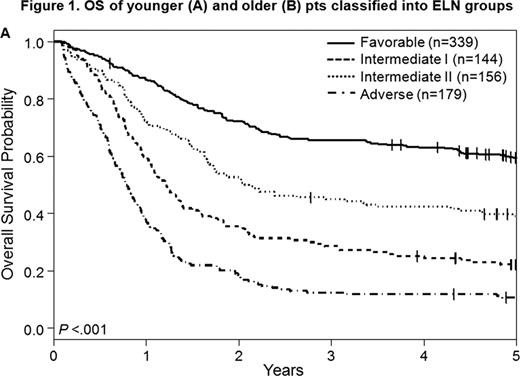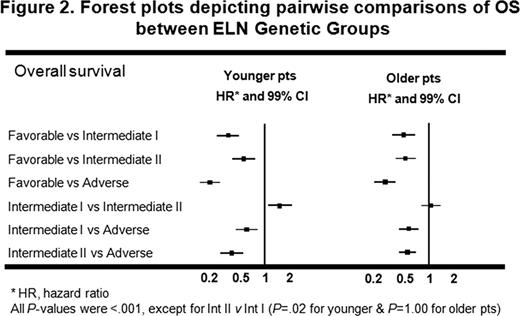Abstract
The ELN standardized system for reporting cytogenetic and select molecular findings was created to enable comparisons of studies correlating treatment outcome with genetic data in AML (Döhner et al. Blood 2010;115:453). The ELN classification is based on published reports on prognostic import of cytogenetic and molecular alterations, but has not been tested in large cohorts of similarly treated AML pts, except for 1 study comprising ∼20% secondary AML pts (Röllig et al. JCO 2011;29:2758). Thus our goal was to assess the prognostic utility of the ELN classification in a relatively large cohort lacking the confounding effects of AML type (de novo v secondary) or different therapies [chemotherapy v allogeneic stem cell transplant (SCT)]. We analyzed 1,550 de novo AML pts (excluding AML M3, which is not part of the ELN classification) treated with cytarabine-daunorubicin-based chemotherapy on Cancer and Leukemia Group B frontline protocols; no pt received SCT in 1st complete remission (CR). Since consolidation therapy of younger [<60 years (y)] and older ('60 y) pts differed in intensity, we analyzed younger (n=818; median age 44 y, range 17–59) and older (n=732, median age 69 y, range 60–86) pts separately.
The pts were classified into the 4 ELN Genetic Groups: Favorable (Fav), Intermediate I (Int I), Intermediate II (Int II) or Adverse (Adv). Younger pts were classified in the Fav Group twice as often and in the Int II and Adv Groups ∼30% less often than older pts (Table 1). Within the Fav Group, core binding factor AML [t(8;21), inv(16) or t(16;16)] was twice as common (P<.001) and NPM1-mut/FLT3-ITD– half as common in younger than in older pts. In the Int I Group, NPM1-mut/FLT3-ITD+ was more common in younger and NPM1-wt/FLT3-ITD– in older pts, whereas in the Int II Group, t(9;11) was twice more common in younger pts. In the Adv Group, pts with balanced cytogenetic abnormalities (abns), ie, inv(3) or t(3;3), t(6;9) and t(v;11)(v;q23), were mainly younger, and pts with –7 mainly older (Table 1).
Distribution of ELN Groups and subsets in 818 younger and 732 older pts
| Genetic Group Subset . | Younger Pts %* . | Older Pts %* . | P . |
|---|---|---|---|
| Fav | 41 | 20 | <.001 |
| t(8;21) | 22 | 13 | .01 |
| inv(16) or t(16;16) | 33 | 12 | <.001 |
| NPM1-mut, no FLT3-ITD† | 28 | 54 | <.001 |
| CEBPA-mut† | 17 | 20 | .44 |
| Int I | 18 | 19 | .64 |
| NPM1-mut & FLT3-ITD† | 55 | 38 | .006 |
| NPM1-wt & FLT3-ITD† | 10 | 12 | .85 |
| NPM1-wt, no FLT3-ITD† | 35 | 50 | .01 |
| Int II | 19 | 30 | <.001 |
| t(9;11) | 11 | 5 | .05 |
| Cytogenetic abns not classified as Fav or Adv | 89 | 95 | .05 |
| Adv | 22 | 31 | <.001 |
| inv(3) or t(3;3) | 8 | 3 | .03 |
| t(6;9) | 4 | 1 | .02 |
| t(v;11)(v;q23) | 15 | 6 | .01 |
| −5 or del(5q) | 3 | 3 | .78 |
| −7 | 5 | 12 | .02 |
| abn(17p) | 0 | 0 | — |
| Complex karyotype (≥3 abns) | 65 | 75 | .04 |
| Genetic Group Subset . | Younger Pts %* . | Older Pts %* . | P . |
|---|---|---|---|
| Fav | 41 | 20 | <.001 |
| t(8;21) | 22 | 13 | .01 |
| inv(16) or t(16;16) | 33 | 12 | <.001 |
| NPM1-mut, no FLT3-ITD† | 28 | 54 | <.001 |
| CEBPA-mut† | 17 | 20 | .44 |
| Int I | 18 | 19 | .64 |
| NPM1-mut & FLT3-ITD† | 55 | 38 | .006 |
| NPM1-wt & FLT3-ITD† | 10 | 12 | .85 |
| NPM1-wt, no FLT3-ITD† | 35 | 50 | .01 |
| Int II | 19 | 30 | <.001 |
| t(9;11) | 11 | 5 | .05 |
| Cytogenetic abns not classified as Fav or Adv | 89 | 95 | .05 |
| Adv | 22 | 31 | <.001 |
| inv(3) or t(3;3) | 8 | 3 | .03 |
| t(6;9) | 4 | 1 | .02 |
| t(v;11)(v;q23) | 15 | 6 | .01 |
| −5 or del(5q) | 3 | 3 | .78 |
| −7 | 5 | 12 | .02 |
| abn(17p) | 0 | 0 | — |
| Complex karyotype (≥3 abns) | 65 | 75 | .04 |
For genetic subsets, % are calculated within each Genetic Group
Pts with cytogenetically normal AML
Outcomes according to the ELN Groups
| Outcome . | Fav . | Int I . | Int II . | Adv . | P . |
|---|---|---|---|---|---|
| Younger pts, n=818 | n=339 | n=144 | n=156 | n=179 | |
| CR rate, % | 96 | 76 | 79 | 50 | <.001 |
| DFS, median, y | 5.5 | 0.8 | 1.2 | 0.6 | .001 |
| OS, median, y | 11.5 | 1.2 | 2.1 | 0.8 | <.001 |
| Older pts, n=732 | n=145 | n=136 | n=222 | n=229 | |
| CR rate, % | 83 | 61 | 63 | 39 | <.001 |
| DFS, median, y | 1.1 | 0.6 | 0.7 | 0.5 | <.001 |
| OS, median, y | 1.6 | 0.9 | 0.9 | 0.5 | <.001 |
| Outcome . | Fav . | Int I . | Int II . | Adv . | P . |
|---|---|---|---|---|---|
| Younger pts, n=818 | n=339 | n=144 | n=156 | n=179 | |
| CR rate, % | 96 | 76 | 79 | 50 | <.001 |
| DFS, median, y | 5.5 | 0.8 | 1.2 | 0.6 | .001 |
| OS, median, y | 11.5 | 1.2 | 2.1 | 0.8 | <.001 |
| Older pts, n=732 | n=145 | n=136 | n=222 | n=229 | |
| CR rate, % | 83 | 61 | 63 | 39 | <.001 |
| DFS, median, y | 1.1 | 0.6 | 0.7 | 0.5 | <.001 |
| OS, median, y | 1.6 | 0.9 | 0.9 | 0.5 | <.001 |
No relevant conflicts of interest to declare.

This icon denotes a clinically relevant abstract
Author notes
Asterisk with author names denotes non-ASH members.




This feature is available to Subscribers Only
Sign In or Create an Account Close Modal